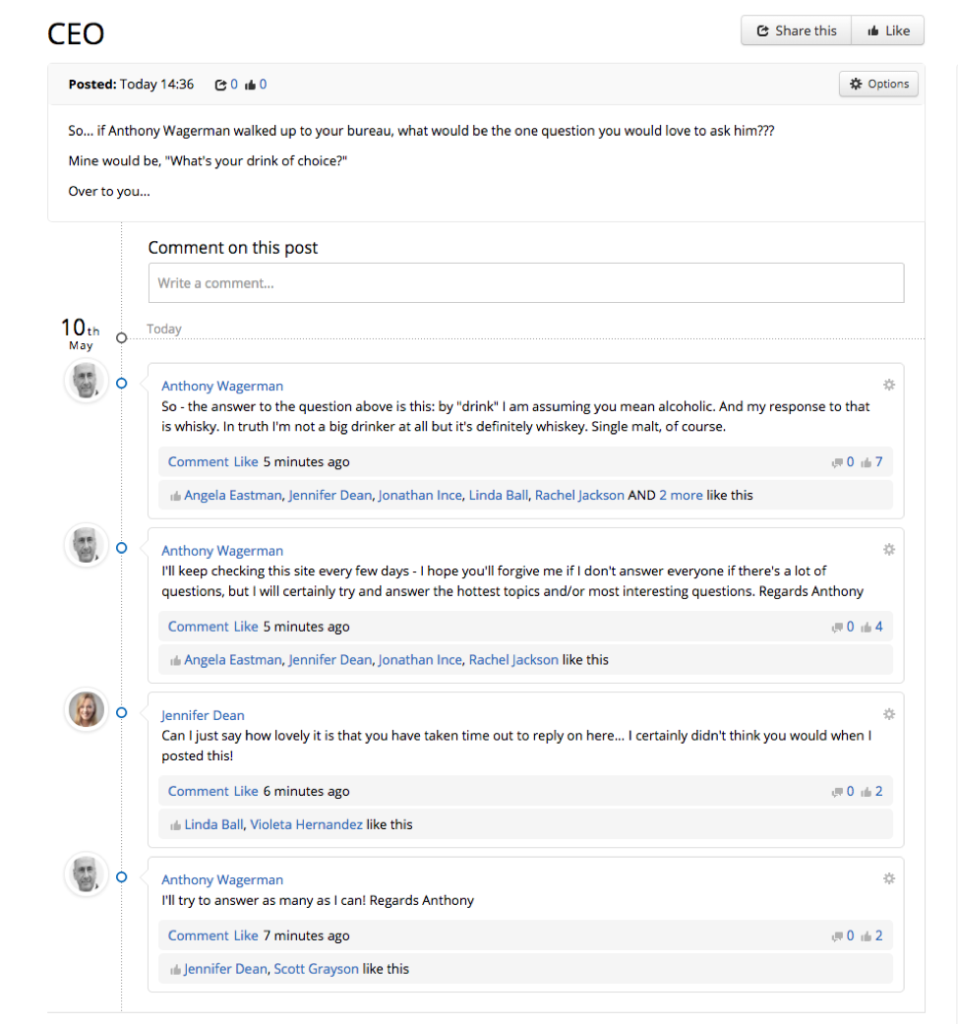Is your C-suite bungling your corporate communications? 5 common mistakes your leaders are making
Your executives are often known as the champions for growth. The makers of change. The strength that pushes for improvement and success in your organization. But oft times, amidst the chaos of keeping the wheels of success turning, the responsibilities of crafting corporate communications and connecting with staff are neglected.
Your employees will always want to hear from leadership, whether it be for updates, inspiration or urgent news. But when corporate communications are treated like an unwanted stepchild, the needs of your staff do not get the attention they deserve.
Your employees crave more than scattered or worse, completely absent communications. Tribe’s national research determined that 72% of employees of large companies want to hear directly from management. Over 84% of them say they don’t hear from corporate management enough.
This isn’t to say that executives do not attempt to communicate. In large companies we often see leadership making an effort to engage employees with methods such as emails, memos, and one-off meetings. So what is your C-suite doing wrong?
The answer boils down to there being a disconnect in your leaders’ perception of their corporate comms vs. the reality.
If you find that your employees are gaining in dissatisfaction, it is time for your leadership to take a more aware and modern approach to your corporate comms. Here are some common mistakes your executives may be making and the best way to correct them.
1. Leaving comms up to someone else
Those responsible for creating your communications know just how difficult it can be to churn out good content consistently. More than 70% of marketers say they lack a consistent or integrated content strategy. Keeping up with content creation is tough even when it’s your responsibility, so it’s understandable that CEOs may have a little trouble finding time to communicate in the midst of all their everyday tasks.
But, just because it’s difficult doesn’t mean your executives should leave the task to someone one else. At the end of the day, your employees want to hear directly from leadership – not a suitable and eloquently written speech from management with absolutely no personal touch.
To key lies in the effort put forth. As easy as it is for leadership to merely sign off on communications prepared by other staff, your C-suite is missing out on a tremendous opportunity to engage employees with their leadership.
Your C-suite must realize that mobilizing and engaging a workforce is something only a leader can do; trying to cut corners will only be detrimental in the long run.
CEO Rahul Pai and CIO Suren Shetty from the payment solutions brand UAE Exchange understood just how crucial complete support was in stabilizing the creation process for their new intranet Connect. Knowing that their company had high standards for their intranet, Rahul and Suren guided their staff in order to help them realize their goals. These leaders took time out of their busy schedules to review content, suggest tweaks and changes to the journey and supported the team in any technical areas by assigning a single point of contact.

With their C-suite behind them, the UAE staff was able to put their best efforts into creating Connect, an intranet that ultimately won the Best Stakeholder Awards in the 2017 Interact Excellence Awards.
When your leaders take a personal interest in the success of their staff and organization, their input and expertise can increase productivity and inspiring colleagues to become equally as engaged.
2. Being inauthentic
Leaving communications entirely up to another party is one thing, but attempting to pass off someone else’s content as your own is even more hazardous.
Senior leaders that do not understand the correlation between genuine internal communications and employee engagement are not as rare as one may think. Authenticity in your internal comms matters more now than ever.
Think your employees won’t notice? Well, think again. The modern employee is like a bloodhound when it comes to fakes – they can sniff them out a mile away. One clue that the content isn’t from their executives, and they will eventually reject the entire message regardless of its importance.
Often the C-suite leans on things like ghostwritten blogs and scripted videos to get the necessary communications out to staff without realizing that those methods are more detrimental to their cause.
Hoodwinking your employees with the equivalent of corporate spam will only serve to lower the credibility of your company’s executives.
CEO of Travelex, Anthony Wagerman, is an excellent example of the benefits that an engaged stakeholder and genuine comms can have on your workforce. Anthony became a sort of celebrity on the company intranet, The Lounge, due to his honest and open approach to communications. Whether its publishing weekly “Friday Night Updates” to the 76 members of the senior leadership team or uploading a monthly vlog where he shares what he’s been up to and how the business is performing, Anthony has perfected the art of authentic communication.

The staff appreciated him taking time out of his day to relate to them, and in return, his active engagement and enthusiasm spread to the rest of the Travelex team.
3. The information grapevine
What your leaders say is just as important as how they distribute the news. We all hear things through the metaphorical grapevine, but when it comes to your organization, critical information should be delivered first-hand.
Reasonably, it is difficult for executives to travel through the organization sharing updates with every employee, especially for large companies with a large number of non-desk and remote workers. However, cascading information through managers should not be the only method of communication.
Having management relay messages can be useful at times, but if the staff does not have a good relationship with their managers, they can be left even more dissatisfied with the attempt.
There are many times when your staff needs to hear directly from top management but location, and time makes it difficult.
We are aware of the social technologies and collaboration methods that are consistently developed to improve the connection and relationship between staff members, but surprisingly these very same advances can be used to reach out to corporate.
Utilizing popular methods like mobile-optimized versions of corporate intranets, Enterprise Social Network apps (such as Slack, Microsoft Teams, Skype), an intranet or enterprise app with push notifications or even just simple texting can make the difference between an engaged employee and a dissatisfied one.
Still having trouble reaching your dispersed workforce? Our recent blog explores some more ways to connect to your non-desk and remote based workers.
4. Not speaking the language
You may think being c-suite is all about walking the walk but talking the talk is just as critical. And no, I do not mean the hated “corporate speak”. If you want to connect with your staff, you’ll need to communicate with them in a way that is real, appreciated, and far removed from the impersonal corporate jargon.
The people want authenticity. Talking in circles, or putting on a front is not the way to get what you want – engagement. Executives need to adjust their speech and the methods they share information in order to appeal to your staff on a deeper level.
Consider things like tone and cadence. Sometimes it’s not what you say but how you say it. Try to dampen the technical phrasing, but be careful not to come across as insincere. Don’t change your complete personality, but read the room to figure out how to deliver your message.
5. Not thinking outside the box
If you’re still using outdated methods of communication such as email and memos, then you are on the fast track to failure. Your workforce and their expectations have advanced, and without a sophisticated and modern approach to communications, you face the risk of alienating your staff further.
Making comms a priority does not always have to be a challenge. Sometimes it’s as easy as finding the channel of communication that is most comfortable for your company executives.
Take a page from Craig Sanderson’s book. During the creation of their new intranet, Linkipedia, the CEO of Link Group, Craig, made an exemplary effort to stray away from the more traditional methods of communication.
He showed his commitment by becoming one of the beloved mascots in cartoon form for the intranet’s animated video, created to showcase all the useful features of Linkipedia. He followed with a welcome blog that outlined the key objectives that led the communications team to tackle this intranet project.

Craig inspired numerous requests for more updates and visibility on the intranet with his open and unique approach to corporate communication. This even lead to information from the senior management and board meetings being published in the Team Updates section of the intranet, further building links between senior management and their frontline.
Whether it is a tweet, video, or podcast, the actual channel does not matter. What is important is that your employees are engrossed and can experience direct and engaging communications directly from leadership.
While management does recognize the importance of internal communications as a practice, corporate communications are still too often undervalued – something that leads to poor engagement and negatively effects the organization as a whole.
These five common mistakes are easily resolved and can make a world of difference for those organizations suffering from poor corporate comms. A C-suite that places high importance on the role of communication can be a guiding light toward success for any company.
